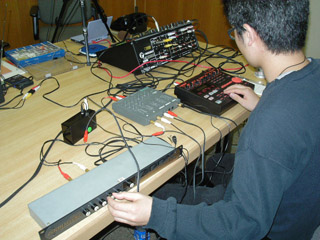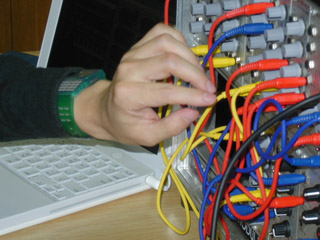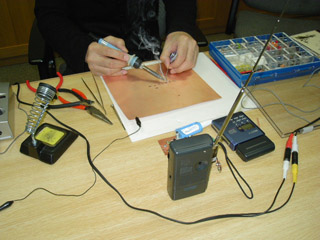Radio Kinesonus on November 16, 2003
01:00 - Kenji Maehara improvised with his several devices.
02:00 - Keith de Mendonca, London connected his server to Kinesonus.
02:25 - Hiroshi Hasegawa played his computer and devices.
03:30 - Jean-Paul Jacquet, Brussels phoned Sun Ok Papi K.O.'s play.
04:00 - Tetsuo Kogawa moved made a small transmitter and played it.
Artists' Comments and live pictures

 Real
Real
Sun ok papi k.o. came for a live with 2 freshly acquired machines: one very
promising as he said and full of faders, the other was the crakelbox. The result a real manipulation with fuzzy proclivity. The Cracklebox was probably the first portable selfpowered analog synthesizer with inbuilt loudspeaker. Nowadays The Cracklebox is the archetype of 'circuitbending', 'glitch', 'Touch' and 'crackle'. Comp. : Michel Waisvisz' site.
- Jean-Paul Jacquet

 Real
Real
The November broadcast is entitled "Near Silence". The first track is "Noise Reduction", by UK artist Wem. It was created from sounds made by the noise reduction feature of the Cool EditPro software package when applied to silent gaps in a sound source. Next, a field recording of the 2 minutes of silence during the Remembrance Sunday ceremony that takes place every November in the centre of London. And finally - "No Input Mixing Board 7" by Toshimaru Namakura. A piece generated entirely from a mixing desk with its output connected back into an input channel, and with no other input sound sources.
- Keith de Mendonca

 Real
Real
["Actions speak louder than words".]
- Kenji Maehara

 Real
Real
After all, the sound with proper "ma" can be heard very musical. In that logic, my performance could be unmusical. But I think "noise" is nothing but something like that.
I've left spaces on this comments section last two times. Although it's against my style, I dare do the way here at times as music.
-Hiroshi Hasegawa

 Real
Real
This is a newer and shorter version of my radio art sound performance that I did at Radiophon'ic 2003 in Brussels on November 7, 2003. The waving moves of my hands to build a transmitter and the sounds that the moves directly and indirectly (mediated by an effector) created are shown. The last voice reads "La vraie condition de l'homme, c'est de penser avec ses mains "
from Denis de Rougemont's 'Penser avec les mains' (1936). I find the basic direction of my performance in this passages.
- Tetsuo Kogawa
 Real
Real



